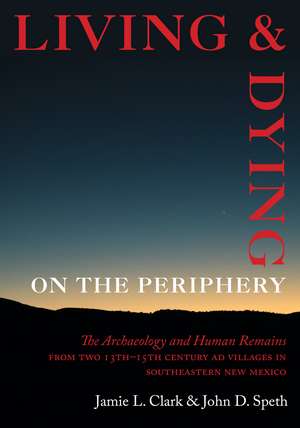Living and Dying on the Periphery: The Archaeology and Human Remains from Two 13th-15th Century AD Villages in Southeastern New Mexico
Autor Jamie L. Clark, John D. Spethen Limba Engleză Hardback – 29 sep 2022
Summarizing results from eight seasons of research, Clark and Speth document human burials and associated grave offerings from the two sites. They discuss evidence for pathologies and trauma, raising questions about the nature and causes of violence that led to the demise of Henderson and Bloom Mound, and the abandonment of many other farming-hunting communities in the surrounding region.
Preț: 575.65 lei
Preț vechi: 702.02 lei
-18% Nou
Puncte Express: 863
Preț estimativ în valută:
110.18€ • 114.83$ • 91.72£
110.18€ • 114.83$ • 91.72£
Carte indisponibilă temporar
Doresc să fiu notificat când acest titlu va fi disponibil:
Se trimite...
Preluare comenzi: 021 569.72.76
Specificații
ISBN-13: 9781647690533
ISBN-10: 1647690536
Pagini: 370
Ilustrații: 70 illustrations, 9 maps
Dimensiuni: 178 x 254 x 28 mm
Greutate: 0.95 kg
Editura: University of Utah Press
Colecția University of Utah Press
ISBN-10: 1647690536
Pagini: 370
Ilustrații: 70 illustrations, 9 maps
Dimensiuni: 178 x 254 x 28 mm
Greutate: 0.95 kg
Editura: University of Utah Press
Colecția University of Utah Press
Recenzii
“This is a severely understudied region that has a fascinating but enigmatic place in the prehistory of the southwestern US/northwestern Mexico. Clark and Speth provide an intriguing synthesis of the current state of knowledge, stitching together more than two decades of excavation to place both sites into local and regional context. The synthesis is thoughtful, original, and provocative.”
— Thomas R. Rocek, professor of anthropology, University of Delaware
— Thomas R. Rocek, professor of anthropology, University of Delaware
Notă biografică
Jamie L. Clark is assistant professor of anthropology in the Department of Sociology and Anthropology at George Mason University. She is coeditor (with John D. Speth) of Zooarchaeology and Modern Human Origins: Human Hunting Behavior During the Later Pleistocene.
John D. Speth is Arthur F. Thurnau Professor emeritus of Anthropology in the Department of Anthropology at the University of Michigan. His books include Zooarchaeology and Modern Human Origins: Human Hunting Behavior During the Later Pleistocene (coedited with Jamie L. Clark); The Paleoanthropology and Archaeology of Big-Game Hunting: Protein, Fat, or Politics?; and Human Paleoecology in the Levantine Corridor (coedited with Naama Goren-Inbar).
John D. Speth is Arthur F. Thurnau Professor emeritus of Anthropology in the Department of Anthropology at the University of Michigan. His books include Zooarchaeology and Modern Human Origins: Human Hunting Behavior During the Later Pleistocene (coedited with Jamie L. Clark); The Paleoanthropology and Archaeology of Big-Game Hunting: Protein, Fat, or Politics?; and Human Paleoecology in the Levantine Corridor (coedited with Naama Goren-Inbar).
Cuprins
Publisher’s Note
List of Figures
List of Tables
List of Appendices
Preface
Acknowledgments
1. Background to the Excavations at Henderson and Bloom Mound
2. Synthesis of Previous Work at Henderson and Bloom Mound
3. Architecture and Occupational History at Henderson and Bloom Mound
4. Material Culture at Henderson and Bloom Mound: A Synopsis
5. Situating Henderson and Bloom Mound within a Regional Context: Economic Insights
6. Broader Regional Context: Insights from Fox Place and Rocky Arroyo
7. Plains-Pueblo Interaction: Economic Specialists or Dual Economies?
8. Human Remains from Henderson and Bloom Mound: Previously Reported Burials
9. Previously Unreported Burials from the 1994–1997 Excavations at Henderson
10. Previously Unreported Burials from the 2000–2009 Excavations at Bloom Mound
11. Discussion and Conclusions
Appendices
References
Index
Descriere
Sheds light on the archaeology of a little-known region of southeastern New Mexico, whose people hunted bison and traded with Pueblo farmers but later succumbed to intense conflict among competing communities
